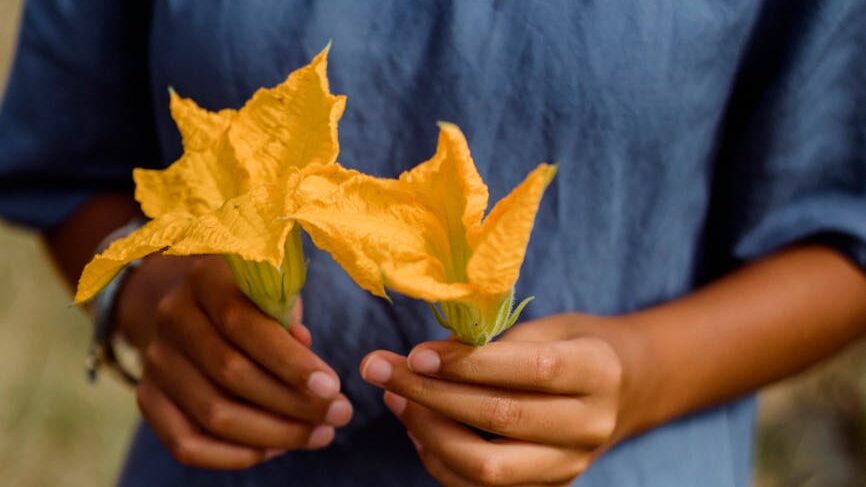The Pumpkin Flower: Nature’s Edible Delight and Its Benefits
Pumpkin flowers are often overlooked in favor of their more famous counterparts—the pumpkins themselves. However, these delicate, vibrant yellow-orange blooms are not only visually appealing but also pack a punch when it comes to nutrition and culinary versatility. In many cultures around the world, pumpkin flowers are a beloved ingredient, and their benefits extend beyond just their taste.
What Are Pumpkin Flowers?
Pumpkin flowers are the blossoms of the pumpkin plant, which belong to the Cucurbitaceae family. The plant produces two types of flowers: male and female. The male flowers are more common and are usually harvested for culinary purposes, while the female flowers develop into the pumpkins we are all familiar with. Both types of flowers are edible, but it’s the male flowers that are typically used in cooking.
Nutritional Value of Pumpkin Flowers
Pumpkin flowers are not only delicious but also nutritious. They are low in calories yet rich in vitamins and minerals. Here’s a quick look at their nutritional profile:
- Vitamins: Pumpkin flowers are an excellent source of vitamin A, which is essential for good vision, immune function, and skin health. They also contain vitamin C, an antioxidant that helps protect the body against free radicals and supports a healthy immune system.
- Minerals: These flowers are rich in calcium, iron, and phosphorus, which are vital for bone health, oxygen transport in the blood, and energy production, respectively.
- Fiber: Pumpkin flowers contain dietary fiber, which aids in digestion and promotes a healthy gut.
Health Benefits of Pumpkin Flowers
- Supports Eye Health:
The high vitamin A content in pumpkin flowers makes them great for maintaining healthy vision. Consuming them can help prevent eye-related conditions such as night blindness and age-related macular degeneration. - Boosts Immunity:
The combination of vitamins A and C in pumpkin flowers contributes to a stronger immune system, helping the body fight off infections and illnesses more effectively. - Promotes Healthy Skin:
Vitamin A, present in pumpkin flowers, is known for its skin benefits. It helps in the production of new skin cells, keeping the skin smooth and radiant. Vitamin C also supports collagen production, which is essential for maintaining skin elasticity. - Supports Bone Health:
The calcium and phosphorus in pumpkin flowers contribute to strong and healthy bones. Regular consumption can help in preventing bone-related disorders like osteoporosis. - Aids Digestion:
The fiber content in pumpkin flowers promotes healthy digestion by adding bulk to the stool and preventing constipation. It also supports a healthy gut microbiome.
Culinary Uses of Pumpkin Flowers
Pumpkin flowers are incredibly versatile in the kitchen. Here are some popular ways to enjoy them:
- Stuffed Pumpkin Flowers: One of the most popular ways to prepare pumpkin flowers is to stuff them with a mixture of cheese, herbs, and spices, then lightly batter and fry them until golden and crispy.
- Pumpkin Flower Fritters: Another delicious option is to dip the flowers in a light batter and fry them to make fritters. These can be served as a snack or a side dish.
- Salads: Fresh pumpkin flowers can be added to salads for a pop of color and a mild, slightly sweet flavor. They pair well with leafy greens, nuts, and a tangy vinaigrette.
- Soups and Stews: In many traditional recipes, pumpkin flowers are added to soups and stews, where they provide both flavor and nutrition.
- Curries and Stir-Fries: In some cultures, pumpkin flowers are used in curries and stir-fries, adding a unique taste and texture to the dish.
Growing Pumpkin Flowers
If you have a garden or some space for a few pots, growing pumpkin flowers can be rewarding. They thrive in warm climates and require plenty of sunlight and water. The flowers bloom during the warmer months, and with a little care, you can enjoy fresh pumpkin flowers straight from your garden.
Conclusion
Pumpkin flowers are a hidden gem in the culinary world, offering not only a range of health benefits but also endless possibilities in the kitchen. From supporting eye and skin health to boosting immunity and aiding digestion, these vibrant blooms are more than just a pretty face—they’re a powerhouse of nutrition. So, the next time you spot pumpkin flowers, whether at the market or in your garden, don’t hesitate to add them to your diet and experience their delightful taste and health benefits firsthand. Happy cooking!






